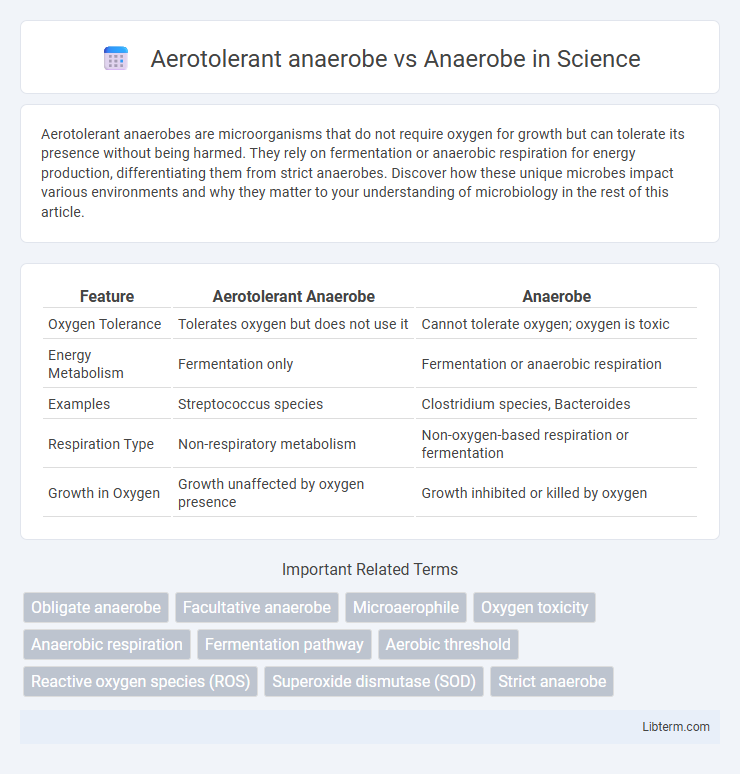Aerotolerant anaerobes are microorganisms that do not require oxygen for growth but can tolerate its presence without being harmed. They rely on fermentation or anaerobic respiration for energy production, differentiating them from strict anaerobes. Discover how these unique microbes impact various environments and why they matter to your understanding of microbiology in the rest of this article.
Table of Comparison
| Feature | Aerotolerant Anaerobe | Anaerobe |
|---|---|---|
| Oxygen Tolerance | Tolerates oxygen but does not use it | Cannot tolerate oxygen; oxygen is toxic |
| Energy Metabolism | Fermentation only | Fermentation or anaerobic respiration |
| Examples | Streptococcus species | Clostridium species, Bacteroides |
| Respiration Type | Non-respiratory metabolism | Non-oxygen-based respiration or fermentation |
| Growth in Oxygen | Growth unaffected by oxygen presence | Growth inhibited or killed by oxygen |
Introduction to Aerotolerant Anaerobes and Anaerobes
Aerotolerant anaerobes are microorganisms that do not require oxygen for growth but can survive and metabolize in its presence, unlike strict anaerobes that are harmed or killed by oxygen. These bacteria utilize fermentation or anaerobic respiration to generate energy, maintaining metabolic processes regardless of oxygen availability. Understanding the distinction between aerotolerant anaerobes and obligate anaerobes is crucial for microbial ecology, industrial applications, and clinical microbiology.
Defining Aerotolerant Anaerobes
Aerotolerant anaerobes are microorganisms that do not require oxygen for growth but can survive and metabolize in its presence by using fermentation processes. Unlike strict anaerobes, which are inhibited or killed by oxygen due to the lack of enzymes like superoxide dismutase and catalase, aerotolerant anaerobes possess these enzymes, allowing them to tolerate oxidative stress. This capacity enables aerotolerant anaerobes to inhabit diverse environments where oxygen levels fluctuate while maintaining anaerobic metabolic pathways.
Understanding True Anaerobes
True anaerobes are microorganisms that cannot survive in the presence of oxygen, as it disrupts their metabolic processes and often leads to cell damage or death. Aerotolerant anaerobes differ by tolerating oxygen and continuing to metabolize without using it, relying on fermentation rather than respiration. Understanding true anaerobes is essential for accurate identification and treatment in clinical microbiology, where oxygen sensitivity defines their isolation and growth requirements.
Key Differences in Oxygen Tolerance
Aerotolerant anaerobes can survive and grow in the presence of oxygen but do not use it for respiration, relying on fermentation pathways instead. In contrast, obligate anaerobes cannot tolerate oxygen, as it is toxic to their cellular components, and they solely depend on anaerobic respiration or fermentation for energy production. This key difference in oxygen tolerance affects their ecological niches and metabolic strategies.
Metabolic Pathways and Energy Production
Aerotolerant anaerobes utilize fermentation as their primary metabolic pathway, allowing them to generate ATP without oxygen by converting glucose into various end products such as lactic acid. In contrast, strict anaerobes rely exclusively on anaerobic respiration or fermentation, lacking mechanisms to detoxify reactive oxygen species and often using alternative electron acceptors like sulfate or nitrate to produce energy. Both groups produce ATP through substrate-level phosphorylation, but aerotolerant anaerobes tolerate oxygen exposure without using it for respiration, while strict anaerobes are inhibited or killed by oxygen presence.
Environmental Niches and Habitats
Aerotolerant anaerobes thrive in environments containing oxygen but do not utilize it for growth, commonly inhabiting soil, gastrointestinal tracts, and fermented foods where oxygen presence fluctuates. Strict anaerobes occupy habitats devoid of oxygen such as deep sediments, anaerobic sludge, and the lower gastrointestinal tract, relying on strictly oxygen-free conditions for survival. Both groups exploit ecological niches defined by oxygen availability, with aerotolerant anaerobes showing broader tolerance in transitional zones compared to the obligate anaerobic habitats favored by strict anaerobes.
Examples of Common Species
Aerotolerant anaerobes such as Lactobacillus species can survive in the presence of oxygen but do not use it for growth, commonly found in the human gut and oral cavity. Strict anaerobes like Clostridium and Bacteroides species cannot tolerate oxygen and are prevalent in environments like deep tissues and the gastrointestinal tract where oxygen is absent. Examples highlight the ecological niches and metabolic adaptations of these bacteria in both health and disease contexts.
Implications in Health and Disease
Aerotolerant anaerobes survive in the presence of oxygen but do not use it for growth, distinguishing them from strict anaerobes that are inhibited or killed by oxygen, which impacts their roles in human microbiota and infectious diseases. Aerotolerant anaerobes, such as Lactobacillus species, contribute to maintaining gut homeostasis and preventing pathogen colonization, while strict anaerobes like Clostridium species are often implicated in severe infections and dysbiosis. Understanding the oxygen tolerance of anaerobic bacteria is crucial for developing targeted therapies for conditions like periodontal disease, colorectal cancer, and anaerobic infections.
Laboratory Identification and Culturing
Aerotolerant anaerobes can survive in the presence of oxygen but do not use it for growth, making them identifiable by growth in both aerobic and anaerobic conditions without oxygen consumption, whereas strict anaerobes require oxygen-free environments for culturing and will not grow or may die in oxygen presence. Laboratory identification involves incubating samples in anaerobic chambers or jars with anaerobic gas packs for strict anaerobes, while aerotolerant anaerobes grow consistently under both aerobic and anaerobic incubation. Selective media and redox indicators such as resazurin can help differentiate between these microbes during culturing, as aerotolerant anaerobes will exhibit growth in oxygenated conditions unlike strict anaerobes.
Applications in Industry and Research
Aerotolerant anaerobes, unlike strict anaerobes, tolerate oxygen exposure, making them advantageous in industrial fermentation processes where complete oxygen exclusion is challenging, such as in yogurt and cheese production. Anaerobes, requiring oxygen-free environments, are primarily used in biogas production and wastewater treatment for efficient organic matter degradation. Research applications leverage aerotolerant anaerobes to study metabolic pathways under microaerophilic conditions, while strict anaerobes help explore energy generation and novel enzymes in strictly anoxic environments.
Aerotolerant anaerobe Infographic

 libterm.com
libterm.com